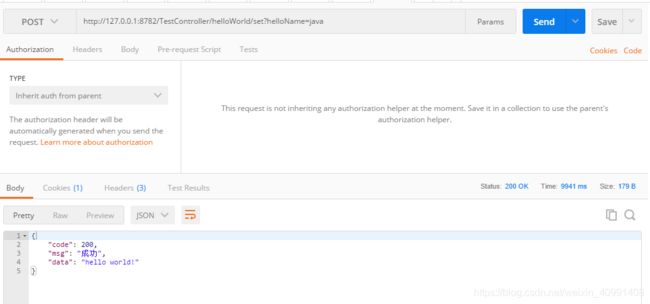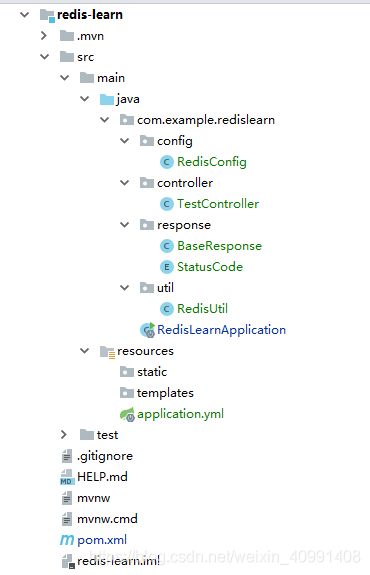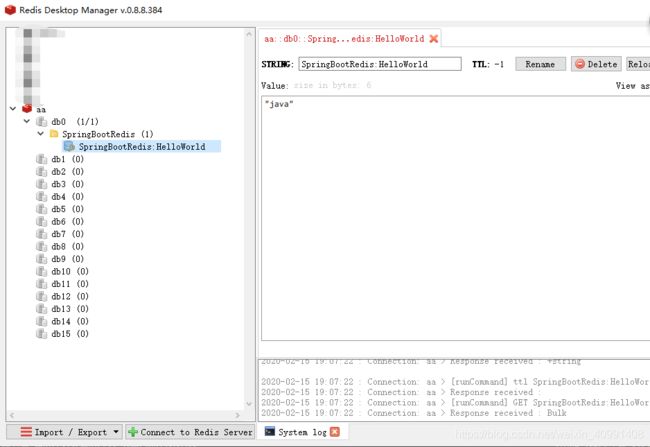SpringBoot 整合Redis 快速上手
一.先创建一个redis-learn 的项目
二. 在pom.xml中引入Redis的和相关依赖依赖,代码如下:
org.springframework.boot
spring-boot-starter-redis
1.4.1.RELEASE
org.springframework.boot
spring-boot-starter-data-redis-reactive
2.1.3.RELEASE
org.springframework.cloud
spring-cloud-starter-netflix-eureka-client
org.springframework.boot
spring-boot-starter-web
org.springframework.boot
spring-boot-starter-test
test
com.alibaba
fastjson
1.2.13
三.application.yml的代码如下:
server:
port: 8782
spring:
#配置程序名为redis-learn
application:
name: redis-learn
#redis 单机配置
redis:
#Redis数据库索引(默认为0)
database: 0
#Redis服务器地址
host: 127.0.0.1
#Redis服务器连接端口
port: 6379
#Redis服务器连接密码
password: 123456
#客户端超时时间单位是毫秒 默认是2000
timeout: 1000
pool:
#连接池的最大数据库连接数。设为0表示无限制,如果是jedis 2.4以后用redis.maxTotal
max-active: 200
#最大建立连接等待时间。如果超过此时间将接到异常。设为-1表示无限制。
max-wait: -1
#连接池中的最大空闲连接
max-idle: 8
#连接池中的最小空闲连接
min-idle: 0
#集群配置
#spring.redis.cluster.nodes=127.0.0.1:6379,127.0.0.1:6380,127.0.0.1:6381,127.0.0.1:6382
四.创建配置类:RedisConfig、工具类:RedisUtil、测试类:TestController、基础响应类:BaseResponse、状态码枚举StatusCode
4.1 创建配置类 RedisConfig,代码如下:
package com.example.redislearn.config;
import org.apache.commons.lang.StringUtils;
import org.slf4j.Logger;
import org.slf4j.LoggerFactory;
import org.springframework.beans.factory.annotation.Autowired;
import org.springframework.beans.factory.annotation.Value;
import org.springframework.cache.annotation.EnableCaching;
import org.springframework.context.annotation.Bean;
import org.springframework.context.annotation.Configuration;
import org.springframework.data.redis.connection.RedisConnectionFactory;
import org.springframework.data.redis.connection.jedis.JedisConnectionFactory;
import org.springframework.data.redis.core.RedisTemplate;
import org.springframework.data.redis.core.StringRedisTemplate;
import org.springframework.data.redis.serializer.Jackson2JsonRedisSerializer;
import org.springframework.data.redis.serializer.RedisSerializer;
import org.springframework.data.redis.serializer.StringRedisSerializer;
import redis.clients.jedis.JedisPoolConfig;
/**
* StringRedisTemplate与RedisTemplate区别点
* 两者的关系是StringRedisTemplate继承RedisTemplate。
*
* 两者的数据是不共通的;也就是说StringRedisTemplate只能管理StringRedisTemplate里面的数据,RedisTemplate只能管理RedisTemplate中的数据。
*
* 其实他们两者之间的区别主要在于他们使用的序列化类:
* RedisTemplate使用的是JdkSerializationRedisSerializer 存入数据会将数据先序列化成字节数组然后在存入Redis数据库。
* StringRedisTemplate使用的是StringRedisSerializer
*
* 使用时注意事项:
* 当你的redis数据库里面本来存的是字符串数据或者你要存取的数据就是字符串类型数据的时候,那么你就使用StringRedisTemplate即可。
* 但是如果你的数据是复杂的对象类型,而取出的时候又不想做任何的数据转换,直接从Redis里面取出一个对象,那么使用RedisTemplate是更好的选择。
*/
//开启缓存(注解生效的)
@EnableCaching
@Configuration
public class RedisConfig {
private Logger logger = LoggerFactory.getLogger(RedisConfig.class);
//Redis数据库索引(默认为0)
@Value("${spring.redis.database}")
private int database;
//Redis服务器地址
@Value("${spring.redis.host}")
private String host;
//Redis服务器连接端口
@Value("${spring.redis.port}")
private int port;
//Redis服务器连接密码
@Value("${spring.redis.password}")
private String password;
//客户端超时时间单位是毫秒 默认是2000
@Value("${spring.redis.timeout}")
private int timeout;
//连接池的最大数据库连接数。设为0表示无限制,如果是jedis 2.4以后用redis.maxTotal
@Value("${spring.redis.pool.max-active}")
private int maxActive;
//最大建立连接等待时间
@Value("${spring.redis.pool.max-wait}")
private long maxWaitMillis;
//连接池中的最大空闲连接
@Value("${spring.redis.pool.max-idle}")
private int maxIdle;
//连接池中的最小空闲连接
@Value("${spring.redis.pool.min-idle}")
private int minIdle;
/**
* 注入 RedisConnectionFactory
*/
@Autowired
private RedisConnectionFactory redisConnectionFactory;
/**
* JedisPoolConfig 连接池
* 用 JedisPoolConfig 是为了缓存连接,减少建立连接的次数,重复利用Jedis,从而提高效率
* @return
*/
@Bean
public JedisPoolConfig jedisPoolConfig() {
try {
JedisPoolConfig jedisPoolConfig = new JedisPoolConfig();
if (!StringUtils.isEmpty(host)) {
logger.info("init JredisPool ......");
//连接池的最大数据库连接数
jedisPoolConfig.setMaxTotal(maxActive);
//最大建立连接等待时间
jedisPoolConfig.setMaxWaitMillis(maxWaitMillis);
//连接池中的最大空闲连接
jedisPoolConfig.setMaxIdle(maxIdle);
//连接池中的最小空闲连接
jedisPoolConfig.setMinIdle(minIdle);
}
return jedisPoolConfig;
}catch (Exception e){
logger.info("init jedisPool error:{}", e);
e.printStackTrace();
}
return null;
}
/**
* 单机版配置
* @param jedisPoolConfig
* @return
*/
@Bean
public JedisConnectionFactory jedisConnectionFactory(JedisPoolConfig jedisPoolConfig){
logger.info("***jedisPoolConfig***"+jedisPoolConfig);
logger.info("init jedisConnectionFactory...");
logger.info("spring.redis.pool.host:{}", this.host);
logger.info("spring.redis.pool.port:{}", this.port);
logger.info("spring.redis.pool.timeout:{}", this.timeout);
logger.info("spring.redis.pool.database:{}", this.database);
logger.info("spring.redis.pool.max-idle:{}", jedisPoolConfig.getMaxIdle());
logger.info("spring.redis.pool.min-idle:{}", jedisPoolConfig.getMinIdle());
logger.info("spring.redis.pool.max-active:{}", jedisPoolConfig.getMaxTotal());
logger.info("spring.redis.pool.max-wait:{}", jedisPoolConfig.getMaxWaitMillis());
JedisConnectionFactory jedisConnectionFactory = new JedisConnectionFactory(jedisPoolConfig);
//连接池
jedisConnectionFactory.setPoolConfig(jedisPoolConfig);
//IP地址
jedisConnectionFactory.setHostName(this.host);
//端口号
jedisConnectionFactory.setPort(this.port);
if (StringUtils.isNotEmpty(this.password)) {
//如果Redis设置有密码
jedisConnectionFactory.setPassword(this.password);
}
//客户端超时时间单位是毫秒
jedisConnectionFactory.setTimeout(this.timeout);
//Redis数据库索引
jedisConnectionFactory.setDatabase(this.database);
//使用连接池
jedisConnectionFactory.setUsePool(true);
return jedisConnectionFactory;
}
/**
* 设置数据存入 redis 的序列化方式,并开启事务
* @return
*/
@Bean
public RedisTemplate functionDomainRedisTemplate() {
RedisTemplate redisTemplate = new RedisTemplate<>();
RedisSerializer stringSerializer = new StringRedisSerializer();
Jackson2JsonRedisSerializer jdkSerializationRedisSerializer = new Jackson2JsonRedisSerializer(Object.class);
redisTemplate.setConnectionFactory(redisConnectionFactory);//会找到它的实现类 JedisConnectionFactory
//如果不配置Serializer,那么存储的时候缺省使用String,如果用User类型存储,那么会提示错误User can't cast to String!
//key采用String的序列化方式
redisTemplate.setKeySerializer(stringSerializer);
// value序列化方式采用jackson
redisTemplate.setValueSerializer(jdkSerializationRedisSerializer);
//hash的key也采用String的序列化方式
redisTemplate.setHashKeySerializer(stringSerializer);
// hash的value序列化方式采用jackson
redisTemplate.setHashValueSerializer(jdkSerializationRedisSerializer);
//开启事务
redisTemplate.setEnableTransactionSupport(true);
return redisTemplate;
}
@Bean
public StringRedisTemplate stringRedisTemplate(){
StringRedisTemplate stringRedisTemplate=new StringRedisTemplate();
stringRedisTemplate.setConnectionFactory(redisConnectionFactory);
return stringRedisTemplate;
}
}
注:
- StringRedisTemplate与RedisTemplate区别点
-
两者的关系是StringRedisTemplate继承RedisTemplate。
-
两者的数据是不共通的;也就是说StringRedisTemplate只能管理StringRedisTemplate里面的数据,RedisTemplate只能管理RedisTemplate中的数据。
- 其实他们两者之间的区别主要在于他们使用的序列化类:
- RedisTemplate使用的是JdkSerializationRedisSerializer 存入数据会将数据先序列化成字节数组然后在存入Redis数据库。
- StringRedisTemplate使用的是StringRedisSerializer。
4.2 创建工具类 RedisUtil,代码如下:
package com.example.redislearn.util;
import com.alibaba.fastjson.JSONArray;
import com.google.common.collect.Lists;
import org.apache.commons.lang.StringUtils;
import org.slf4j.Logger;
import org.slf4j.LoggerFactory;
import org.springframework.beans.factory.annotation.Autowired;
import org.springframework.data.redis.core.RedisTemplate;
import org.springframework.stereotype.Component;
import org.springframework.util.CollectionUtils;
import java.util.List;
import java.util.Map;
import java.util.Set;
import java.util.concurrent.TimeUnit;
import com.alibaba.fastjson.JSON;
/**
* redis工具类
*/
@Component
public class RedisUtil {
private static Logger LOGGER = LoggerFactory.getLogger(RedisUtil.class);
@Autowired
private RedisTemplate redisTemplate;
//=============================common============================
/**
* 指定缓存失效时间
* @param key 键
* @param time 时间(秒)
* @return
*/
public boolean expire(String key,long time){
try {
if(time>0){
redisTemplate.expire(key, time, TimeUnit.SECONDS);
}
return true;
} catch (Exception e) {
e.printStackTrace();
return false;
}
}
/**
* 根据key 获取过期时间
* @param key 键 不能为null
* @return 时间(秒) 返回0代表为永久有效
*/
public long getExpire(String key){
return redisTemplate.getExpire(key,TimeUnit.SECONDS);
}
/**
* 判断key是否存在
* @param key 键
* @return true 存在 false不存在
*/
public boolean hasKey(String key){
try {
return redisTemplate.hasKey(key);
} catch (Exception e) {
e.printStackTrace();
return false;
}
}
/**
* 删除缓存
* @param key 可以传一个值 或多个
*/
@SuppressWarnings("unchecked")
public void del(String ... key){
if(key!=null&&key.length>0){
if(key.length==1){
redisTemplate.delete(key[0]);
}else{
redisTemplate.delete(CollectionUtils.arrayToList(key));
}
}
}
//============================String=============================
/**
* 普通缓存获取
* @param key 键
* @return 值
*/
public Object get(String key){
return key==null?null:redisTemplate.opsForValue().get(key);
}
/**
* 普通缓存放入
* @param key 键
* @param value 值
*/
public void set(String key,Object value) {
try {
redisTemplate.opsForValue().set(key, value);
//redisTemplate.opsForValue().set(key, JSON.toJSONString(value));
//return true;
} catch (Exception e) {
e.printStackTrace();
//return false;
}
}
/**
* 普通缓存放入并设置时间
* @param key 键
* @param value 值
* @param time 时间(秒) time要大于0 如果time小于等于0 将设置无限期
* @return true成功 false 失败
*/
public boolean set(String key,Object value,long time){
try {
if(time>0){
redisTemplate.opsForValue().set(key, value, time, TimeUnit.SECONDS);
}else{
set(key, value);
}
return true;
} catch (Exception e) {
e.printStackTrace();
return false;
}
}
/**
* 递增
* @param key 键
* @param delta 要增加几(大于0)
* @return
*/
public long incr(String key, long delta){
if(delta<0){
throw new RuntimeException("递增因子必须大于0");
}
return redisTemplate.opsForValue().increment(key, delta);
}
/**
* 递减
* @param key 键
* @param delta 要减少几(小于0)
* @return
*/
public long decr(String key, long delta){
if(delta<0){
throw new RuntimeException("递减因子必须大于0");
}
return redisTemplate.opsForValue().increment(key, -delta);
}
//================================Map=================================
/**
* HashGet
* @param key 键 不能为null
* @param item 项 不能为null
* @return 值
*/
public Object hget(String key,String item){
return redisTemplate.opsForHash().get(key, item);
}
/**
* 获取hashKey对应的所有键值
* @param key 键
* @return 对应的多个键值
*/
public Map hmget(String key){
return redisTemplate.opsForHash().entries(key);
}
/**
* HashSet
* @param key 键
* @param map 对应多个键值
* @return true 成功 false 失败
*/
public boolean hmset(String key, Map map){
try {
redisTemplate.opsForHash().putAll(key, map);
return true;
} catch (Exception e) {
e.printStackTrace();
return false;
}
}
/**
* HashSet 并设置时间
* @param key 键
* @param map 对应多个键值
* @param time 时间(秒)
* @return true成功 false失败
*/
public boolean hmset(String key, Map map, long time){
try {
redisTemplate.opsForHash().putAll(key, map);
if(time>0){
expire(key, time);
}
return true;
} catch (Exception e) {
e.printStackTrace();
return false;
}
}
/**
* 向一张hash表中放入数据,如果不存在将创建
* @param key 键
* @param item 项
* @param value 值
* @return true 成功 false失败
*/
public boolean hset(String key,String item,Object value) {
try {
redisTemplate.opsForHash().put(key, item, value);
return true;
} catch (Exception e) {
e.printStackTrace();
return false;
}
}
/**
* 向一张hash表中放入数据,如果不存在将创建
* @param key 键
* @param item 项
* @param value 值
* @param time 时间(秒) 注意:如果已存在的hash表有时间,这里将会替换原有的时间
* @return true 成功 false失败
*/
public boolean hset(String key,String item,Object value,long time) {
try {
redisTemplate.opsForHash().put(key, item, value);
if(time>0){
expire(key, time);
}
return true;
} catch (Exception e) {
e.printStackTrace();
return false;
}
}
/**
* 删除hash表中的值
* @param key 键 不能为null
* @param item 项 可以使多个 不能为null
*/
public void hdel(String key, Object... item){
redisTemplate.opsForHash().delete(key,item);
}
/**
* 判断hash表中是否有该项的值
* @param key 键 不能为null
* @param item 项 不能为null
* @return true 存在 false不存在
*/
public boolean hHasKey(String key, String item){
return redisTemplate.opsForHash().hasKey(key, item);
}
/**
* hash递增 如果不存在,就会创建一个 并把新增后的值返回
* @param key 键
* @param item 项
* @param by 要增加几(大于0)
* @return
*/
public double hincr(String key, String item,double by){
return redisTemplate.opsForHash().increment(key, item, by);
}
/**
* hash递减
* @param key 键
* @param item 项
* @param by 要减少记(小于0)
* @return
*/
public double hdecr(String key, String item,double by){
return redisTemplate.opsForHash().increment(key, item,-by);
}
//============================set=============================
/**
* 根据key获取Set中的所有值
* @param key 键
* @return
*/
public Set 4.3 创建基础响应类 BaseResponse,代码如下:
package com.example.redislearn.response;
/**
* 基础通用的响应类
**/
public class BaseResponse {
private Integer code;
private String msg;
private T data;
public BaseResponse(StatusCode statusCode) {
this.code = statusCode.getCode();
this.msg = statusCode.getMsg();
}
public BaseResponse(Integer code, String msg) {
this.code = code;
this.msg = msg;
}
public BaseResponse(Integer code, String msg, T data) {
this.code = code;
this.msg = msg;
this.data = data;
}
public Integer getCode() {
return code;
}
public void setCode(Integer code) {
this.code = code;
}
public String getMsg() {
return msg;
}
public void setMsg(String msg) {
this.msg = msg;
}
public T getData() {
return data;
}
public void setData(T data) {
this.data = data;
}
}
4.4 创建状态码枚举StatusCode,代码如下:
package com.example.redislearn.response;
/**
* 状态码枚举
**/
public enum StatusCode {
Success(200,"成功"),
Fail(-1,"失败"),
InvalidParams(10010,"非法的参数!"),
UserEmailHasExist(10011,"当前用户邮箱已存在!"),
;
private Integer code;
private String msg;
StatusCode(Integer code, String msg) {
this.code = code;
this.msg = msg;
}
public Integer getCode() {
return code;
}
public void setCode(Integer code) {
this.code = code;
}
public String getMsg() {
return msg;
}
public void setMsg(String msg) {
this.msg = msg;
}
}
4.5 创建测试类TestController,代码如下:
package com.example.redislearn.controller;
import com.example.redislearn.response.BaseResponse;
import com.example.redislearn.response.StatusCode;
import com.example.redislearn.util.RedisUtil;
import io.swagger.annotations.Api;
import org.slf4j.Logger;
import org.slf4j.LoggerFactory;
import org.springframework.beans.factory.annotation.Autowired;
import org.springframework.data.redis.core.StringRedisTemplate;
import org.springframework.web.bind.annotation.RequestMapping;
import org.springframework.web.bind.annotation.RequestMethod;
import org.springframework.web.bind.annotation.RequestParam;
import org.springframework.web.bind.annotation.RestController;
@RestController
@RequestMapping("TestController")
@Api(value = "redis-learn-Controller", description = "redis-learn的Controller")
public class TestController {
private static final Logger log = LoggerFactory.getLogger(TestController.class);
private static final String RedisHelloWorldKey = "SpringBootRedis:HelloWorld";
@Autowired
private RedisUtil redisUtil;
@Autowired
private StringRedisTemplate stringRedisTemplate;
@RequestMapping(value = "/helloWorld/set", method = RequestMethod.POST)
public BaseResponse helloWorldSet(@RequestParam String helloName) {
BaseResponse response = new BaseResponse(StatusCode.Success);
try {
//stringRedisTemplate.opsForValue().set(RedisHelloWorldKey,helloName);
redisUtil.set(RedisHelloWorldKey, helloName);
response.setData("hello world!");
} catch (Exception e) {
log.info("--hello world get异常信息: ", e.fillInStackTrace());
response = new BaseResponse(StatusCode.Fail.getCode(), e.getMessage());
}
return response;
}
@RequestMapping(value = "/helloWorld/get", method = RequestMethod.GET)
public BaseResponse helloWorldGet() {
BaseResponse response = new BaseResponse(StatusCode.Success);
try {
//String result = stringRedisTemplate.opsForValue().get(RedisHelloWorldKey);
String result = redisUtil.get(RedisHelloWorldKey).toString();
response.setData(result);
} catch (Exception e) {
log.info("--hello world get异常信息: ", e.fillInStackTrace());
response = new BaseResponse(StatusCode.Fail.getCode(), e.getMessage());
}
return response;
}
}
五:测试
运行项目,在浏览器或postman输入对应的地址和参数
http://127.0.0.1:8782/TestController/helloWorld/set,结果如下:
Redis 中 已经 有 java 这个结果。

